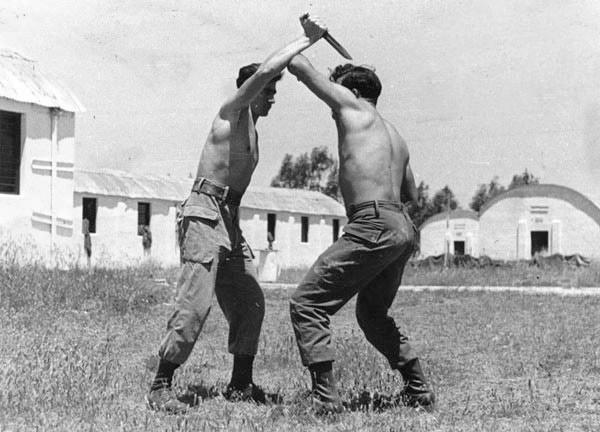
Krav Maga
Krav Maga (/ˌkrɑːv məˈɡɑː/ KRAHV mə-GAH; Hebrew: קְרַב מַגָּע, IPA: [ˈkʁav maˈɡa]; lit. 'contact combat') is an Israeli martial art. Developed for the Israel Defense Forces (IDF),[1][2] it is derived from a combination of techniques used in Aikido, Boxing, Judo, Karate and Wrestling.[3][4] It is known for its focus on real-world situations.[5]
Krav Maga was originally developed by Hungarian-born Israeli martial artist Imi Lichtenfeld. Having grown up in Bratislava during a time of anti-Semitic unrest, Lichtenfeld used his training as a boxer and wrestler to defend Jewish neighborhoods against attackers in the mid-to-late 1930s, becoming an experienced street fighter.[6][7] After his immigration to Mandatory Palestine in the late 1940s, he began to provide lessons on combat training to Jewish paramilitary groups that would later form the IDF during the 1948 Palestine war. As an instructor, he compiled his knowledge and experience into the combat system that would later become known as Krav Maga. This system would continue to be taught long after he left the IDF.[2][8]
From the outset, the original concept of Krav Maga was to take the most effective and practical techniques of other fighting styles (originally European boxing, wrestling, and street fighting) and make them rapidly teachable to conscripted soldiers.[9] It has a philosophy emphasizing aggression[10] and simultaneous defensive and offensive manoeuvres.[11] It has been used by Israeli special forces and regular infantry units alike.[12] Closely related variations have been developed and adopted by Israeli law enforcement and intelligence organizations, and there are several organizations teaching variations of Krav Maga internationally.[13] There are two forms of Krav Maga, with one type adapted for Israeli security forces and the other type adapted for civilian use.[13]
Etymology[edit]
The term krav maga in Hebrew is literally translated as 'contact combat' – the three letter root of the first word is k-r-v (קרב), and the noun derived from this root means either "combat" or "battle",[14][15] while the second word is a participle form derived from the verb root n-g-'a (נגע), that literally means either "contact" or "touch".[15][14]
Like most martial arts, Krav Maga encourages students to avoid physical confrontation.[5] If this is impossible or unsafe, it promotes finishing a fight as quickly and aggressively as possible. Attacks are aimed at the most vulnerable parts of the body, and training is not limited to techniques that avoid severe injury; some even permanently injure or cause death to the opponent.
Students learn to defend against all variety of attacks and are taught to counter in the quickest and most efficient way.
Ideas in Krav Maga include:[16]
Training can also cover the study and development of situational awareness to develop an understanding of one's surroundings, learning to understand the psychology of a street confrontation, and identifying potential threats before an attack occurs. It may also cover physical and verbal methods to avoid violence whenever possible. It also teaches mental toughness, using controlled scenarios to strengthen mental fortitude in order for students to control the impulse and not do something rash, but instead attack only when necessary and as a last resort.
Some of the key focuses of techniques[23] in Krav Maga are—as described above—effectiveness and instinctive response under stress. To that end, Krav Maga is an eclectic system that has not sought to replace existing effective techniques, taking what is useful from available systems, for example: